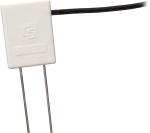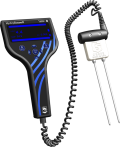
Entworfen zur Langzeitüberwachung






Überblick
Der CS616 misst den volumetrischen Wassergehalt von 0% bis zur Sättigung. Der Sensor gibt eine Schwingungsfrequenz im Megahertz-Bereich aus, die von einem Campbell-Logger abgefragt werden kann.
Lesen Sie mehrFunktionen und Vorteile
- Compatible with most Campbell Scientific data loggers
- High accuracy and high precision
- Fast response time
- Designed for long-term unattended water content monitoring
- Compatible with AM16/32-series multiplexers, allowing measurement of multiple sensors
- Probe rods can be inserted from the surface or buried at any orientation to the surface.
Bilder

Technische Beschreibung
The CS616 is comprised of two 30-cm-long stainless steel rods connected to the measurement electronics. The circuit board is encapsulated in epoxy, and a shielded four-conductor cable is connected to the circuit board to supply power, enable probe, and monitor the output.
The CS616 measures the volumetric water content of porous media (such as soil) using the time-domain measurement method; a reflectometer (cable tester) such as the TDR100 is not required. This method consists of the CS616 generating an electromagnetic pulse. The elapsed travel time and pulse reflection are then measured and used to calculate soil volumetric water content.
Response Characteristics
The signal propagating along the parallel rods of the CS616 is attenuated by free ions in the soil solution and conductive constituents of the soil mineral fraction. In most applications, the attenuation is not enough to affect the CS616 response to changing water content, and the response is well described by the standard calibration. However, in soil with relatively high soil electrical conductivity levels, compacted soils, or soils with high clay content, the calibration should be adjusted for the specific medium. Guidance for making these adjustments is provided in the operating manual.
Kompatibel mit
Please note: The following shows notable compatibility information. It is not a comprehensive list of all compatible products.
Datenlogger
| Product | Compatible | Note |
|---|---|---|
| CR1000 (retired) | ||
| CR1000X (retired) | ||
| CR1000Xe | ||
| CR300 (retired) | ||
| CR3000 | ||
| CR310 | ||
| CR350 | ||
| CR6 | ||
| CR800 (retired) | ||
| CR850 (retired) |
Additional Compatibility Information
RF Considerations
The RF emissions are below FCC and EU limits as specified in EN61326 if the CS616 is enabled less than 0.6 ms, and measurements are made less frequently than once a second. External RF sources can also affect the CS616 operation. Consequently, the CS616 should be located away from significant sources of RF such as ac power lines and motors.
Installation Tool
The CS650G makes inserting soil-water sensors easier in dense or rocky soils. This tool can be hammered into the soil with force that might damage the sensor if the CS650G was not used. It makes pilot holes into which the rods of the sensors can then be inserted. It replaces both the 14383 and 14384.
Data Logger Considerations
The reflectometer connects directly to one of the data logger’s single-ended analog inputs. A data logger control port is typically used to enable the CS616 for the amount of time required to make the measurement. Data logger instructions convert the probe square-wave output to period which is converted to volumetric water content using a calibration.
Spezifikationen
| Measurements Made | Volumetric water content (VWC) of porous media (such as soil) |
| Measurement Range | 0% to saturation |
| Water Content Accuracy | ±2.5% VWC (using standard calibration with bulk EC of ≤ 0.5 dS m-1, bulk density of ≤ 1.55 g cm-3, and measurement range of 0% to 50% VWC) |
| Required Equipment | Measurement system |
| Soil Suitability | Long rods and lower frequency are well-suited for soft soil with low electrical conductivity (< 2 dS/m). |
| Rods | Not replaceable |
| Sensors | Not interchangeable |
| Operating Temperature Range | 0° to +70°C |
| Probe-to-Probe Variability | ±0.5% VWC in dry soil, ±1.5% VWC in typical saturated soil |
| Precision | Better than 0.1% VWC |
| Resolution | 0.1% VWC |
| Output | ±0.7 V square wave (with frequency dependent on water content) |
| Current Drain |
|
| Power Supply Voltage | 5 Vdc minimum; 18 Vdc maximum |
| Enable Voltage | 4 Vdc minimum; 18 Vdc maximum |
| Electromagnetic | CE compliant (Meets EN61326 requirements for protection against electrostatic discharge.) |
| Rod Spacing | 32 mm (1.3 in.) |
| Rod Diameter | 3.2 mm (0.13 in.) |
| Rod Length | 300 mm (11.8 in.) |
| Probe Head Dimensions | 85 x 63 x 18 mm (3.3 x 2.5 x 0.7 in.) |
| Cable Weight | 35 g per m (0.38 oz per ft) |
| Weight | 280 g (9.9 oz) without cable |
Dokumente
Broschüren Produkte
Technische Artikel
Übereinstimmung mit Richtlinien u. Vorschriften
FAQs für
Number of FAQs related to CS616: 36
Alle anzeigenWenige anzeigen
-
The CS616/CS625 will survive frozen soil conditions, but the principle behind using bulk soil dielectric permittivity to estimate water content requires that the water be in liquid form. When soil water freezes, its dielectric drops from approximately 80 to 4, making it indistinguishable from soil solids. Consequently, the CS616/CS625 is not able to measure the water content of frozen soil.
-
No. The output is too fast to be measured on the pulse channel of a 21X or CR7.
-
No. Although the CS616/CS625 could be calibrated to convert its period reading to the dielectric permittivity of snow, there is not an easy way to relate the permittivity to liquid water content. This is because the density of snow changes over time and the amount of liquid water that can be held in the solid matrix is relatively small. Additionally, the sensor emits infrared radiation that melts snow away from its rods, similar to the way snow melts around the base of a tree.
The CS616 and CS625 are not appropriate sensors for this application because of the lack of good contact between the rods and the snow, as well as the dynamic nature of the solid matrix.
-
If the electrical conductivity within the waste is less than 5 dS/m and there is good contact between the probe rods and the waste, the CS616/CS625 should respond predictably to changes in water content. The heterogeneous nature and changing bulk density of solid waste, however, make calibration difficult.
-
Yes, but the CS616/CS625 will need a soil-specific calibration. The high organic matter content of peat will likely cause the CS616/CS625 period to be out of bounds for use with the CS616() CRBasic instruction and P138 Edlog instruction. In that situation, the CRBasic PeriodAvg() instructionor the Edlog P27 Period Average instruction may be used as described in the CS616 and CS625 instruction manual.
-
Yes. The rugged design of the CS616/CS625 protects the probe electronics from water under these conditions. Many CS616/CS625 reflectometers have been working reliably in very wet conditions for more than ten years.
-
The CS616/CS625 can measure volumetric water content over the entire range from completely dry to saturation. A soil-specific calibration will improve accuracy, especially in very dry soil.
-
The period value is corrected to the temperature at which the water content calibration was performed, and then the water content equation is applied to the corrected period. Temperature correction is soil specific because the effect that temperature has on the period value varies with soil texture and electrical conductivity. A temperature correction equation that was developed for a sandy loam soil with low bulk electrical conductivity is provided in the CS616 and CS625 instruction manual.
-
The sensitive volume of the CS616/CS625 varies with water content. A general guideline is that the sensitive volume is within approximately a 32 mm radius from each rod.
-
Some customers have tried to use the CS616 or CS625 to measure the moisture content within a tree, but the calibration proved to be problematic. Campbell Scientific cannot provide any specific guidance for this application.
Anwendungsbeispiele
Tropical volcanic islands are biodiversity hotspots where the Critical Zone (CZ) remains poorly studied. In......lesen Sie mehr
Korea Expressway Corporation (KEC) was established in 1969 to construct and manage expressways throughout South......lesen Sie mehr
The Delaware Environmental Observing System (DEOS) is a real-time system dedicated to monitoring environmental conditions......lesen Sie mehr
The West Texas Mesonet (WTM) project was initiated by Texas Tech University in 1999 to......lesen Sie mehr










